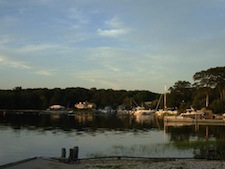
…Among the dirty linen, a tale unfolds
The Independent, August 1993
FOR JANE ZLOBEC, winter was always the most wonderful season in Sag Harbor, and there were snowstorms on her birthday every year.
‘I was born on 5 December 1927,’ she says. ‘I remember drifts 6ft high on Main Street and everyone had to dig their own little driveway. It was beautiful. Not many people here, then. I could tell you stories . . .’
This Sag Harbor Scheherazade is the proprietor of the Whaler’s Dry Cleaners on Main Street. She is second generation Sag Harbor. Has lived a whole life, nearly, on these streets. Knows their secrets. Hers is the only cleaner’s in town: everyone takes their dirty linen there.
‘I saw Teddy Kennedy on the docks last summer; we did some cleaning for him,’ says Jane. She also spotted JFK Jnr at Provisions, the health food restaurant just behind her shop.
All summer I try to get Jane to tell me her stories. I take laundry in. I bring in my best linen pants on which I have dripped Haagen-Dazs Cookie Dough Dynamo ice-cream.
In the shop, I read the newspaper cutting on the wall that shows Jane displaying pictures of local boys who served in the Gulf war. I inspect the sculptures on sale, these being lobster carcasses outfitted as different characters: a lobster golfer, a lobster doctor in physician’s gear labelled ‘Dr Who’. I eye the the candy bowl Jane keeps on the counter where there are miniature Tootsie Rolls.
‘Help yourself,’ Jane always says, nodding her signature platinum blonde beehive hairdo towards the bowl, affable behind her spectacles, deep tan make-up always perfect, pearl ear-rings in place. She is 65. Her feet are encased in open-toe sneakers with frilly socks.
Eventually we fix an early morning date. Mornings for Jane begin around 4.30. I oversleep. My editor calls to ask if I can get myself invited to tea with Thomas Harris, Sag Harbor’s most famous writer, author of The Silence of the Lambs; I am not sure how to take this. It gets hot. Humid. The sky grumbles with impotent thunder that never comes to much. Days drag by. No invites come to glamorous parties attended, I imagine, by the Faxisti, cityfolk who come to live here with fashionable doggies and fax machines.
In my rented house, things fall apart: legs drop off chairs; doors flop off cupboards. My garden resembles Joel the Ripper’s. (Long Island’s latest serial killer was a gardener). I hate the countryside] This is a terrible mistake, this town without pity where I can’t even fix to talk to the dry cleaner.
‘Come on,’ says Jane suddenly, Saturday morning. ‘Let’s go in back and talk before it gets busy.’ We settle in among the laundry and plastic bags and hangers.
Her mother was Sag Harbor born and raised, although Jane’s father came from Massachusetts. When Jane was growing up alongside four sisters and a brother – ‘I was the baby,’ she says – Sag Harbor was an American factory town like a million others.
She went to Pierson High School here, then to college in New Jersey, aiming to be a court stenographer. ‘I didn’t last long. I came back here,’ she says.
Jane went to work at the Bulova watch factory. ‘I met my husband there. Everybody worked there. Everybody made a living. It was very nice.’
The factory is covered with ancient ivy now and boarded up. In the late Fifties, Jane’s husband and his parents bought the building occupied by the dry cleaner’s shop; it, too, had been a factory that closed down. For years things were pretty quiet in Sag Harbor.
‘I’ve never seen it so crowded as this summer,’ says Jane, glancing towards the wharf where tourists disembark from cruise ships, large ferry boats from Connecticut two hours up the coast. Cigar Jocks amble by from the American Hotel on Main Street.
‘My husband always said Sag Harbor was going to be the Malibu of Long Island,’ Jane says. ‘Now I believe him.
‘A lot of new people have moved in,’ she adds. ‘What do they do? They fax this and they fax that, or so they tell me.’
Silently, I will her to trash the Faxisti; at least one of them has confided he thinks ‘most locals are dim- witted knuckleheads who couldn’t cut it anywhere but Sag Harbor’.
‘You have to treat people nice,’ says Jane, who can tell you about Betty Friedan’s operation, and ‘that actor’ Alec Baldwin who was in the other day. ‘Sure, we get some famous people in here. Elaine Steinbeck, she’s a lovely lady, and John, now he was a great person,’ she adds, speaking of the writer, who lived in Sag Harbor, and his widow, who is its grande dame.
‘We treat everyone nice. People who say there’s tensions here just use it as an excuse because they feel bad about something.’
Jane sets off for her hair appointment with Cindy. I get on my bike. A delicious breeze has salted the air, made it crispy. The sun shines. I run into Betsy who owns the kids’ shop and wants to go to the Fireman’s Pancake Breakfast Sunday. Sure, I say. Life is short, let’s eat pancakes. Like a lost sock or a Gene Pitney song, Jane has reclaimed me.